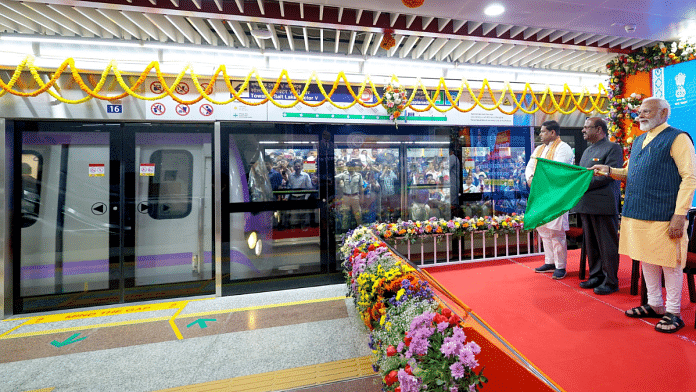New Delhi: Prime Minister Narendra Modi inaugurated India’s first under-river metro route and its deepest metro station in Kolkata Wednesday.
The 520-mt section is an engineering marvel as it has been constructed 13 metres below the Hooghly riverbed (around 40 metres from surface level).
The under-water section is in the route of the 4.8-kilometre stretch between Howarh Maidan and Esplanade stations launched Wednesday. It is a part of the East-West corridor or Kolkata Metro’s Green Line. The corridor is currently 16.6 kilometres, with 10.8 kilometres underground, including the river tunnel.
A train will cover this underwater stretch in just 46 seconds, linking the twin cities of Kolkata and Howrah, which are separated by the Hooghly.
Built at a cost of Rs 4,965 crore, the 4.8-km section has three underground metro stations, including the Howrah station which is constructed 30 metres below the surface and is the deepest in the country. The Howrah Maidan and Howrah stations are on one side of the river and the Mahakaran Station on the other side in Kolkata.
“It is a very special day for the people of Kolkata as the city’s metro system is undergoing significant expansion. This will speed up the communication system and reduce traffic congestion. It is a proud moment that the country’s first underwater metro transport tunnel under a major river of our country has been inaugurated on the Howrah Maidan-Esplanade Metro Branch,” said the PM in a post on X.
কলকাতাবাসীর কাছে এটি অত্যন্ত বিশেষ দিন, কারণ, শহরের মেট্রো ব্যবস্থার উল্লেখযোগ্য সম্প্রসারণ ঘটল। এর ফলে যোগাযোগ ব্যবস্থায় গতি আসবে এবং যানজট কমবে। এটি এক গর্বের মুহূর্ত যে, হাওড়া ময়দান-এসপ্ল্যানেড মেট্রো শাখায় আমাদের দেশের এক প্রধান নদীর নীচে দিয়ে দেশের প্রথম জলনিম্নস্থ… pic.twitter.com/iztQScP6SD
— Narendra Modi (@narendramodi) March 6, 2024
The new metro section is one of the seven metro corridors in the city. Two other corridors were also inaugurated Wednesday by the prime minister, who took an underwater ride with school children.
এই প্রকল্পে যাঁরা কাজ করেছেন তাঁরা এবং এই তরুণদের ধন্যবাদার্হ সঙ্গ পাওয়ায় মেট্রো সফরটি স্মরণীয় হয়ে রইল। হুগলী নদীর নীচে সুড়ঙ্গ দিয়েও যাতায়াত করলাম আমরা। pic.twitter.com/o13N2by8j6
— Narendra Modi (@narendramodi) March 6, 2024
Also read: Not enough commuters? Metros have less than 50% projected ridership, says IIT-D report
The 4.8-km section has twin tunnels. Chief Public Relations Officer of the Kolkata Metro Rail Corporation Kausik Mitra said the East-West corridor has “the distinction of being the very first under-river transportation tunnel in India, below the mighty Hooghly River”.
The underwater stretch — from one centre of the tunnels to the other — was constructed in a record span of 66 days (from April to June in 2017), Mitra said.
Senior Kolkata metro officials said the construction of the twin tunnels was challenging, especially under the riverbed due to the nature of the soil. “The twin subaqueous tunnels located 350 metres downstream of Rabindra Setu (Howrah Bridge) have been burrowed with the help of earth pressure balancing tunnel boring machines through predominantly stiff clayey silt,” Mitra added.
According to Kolkata Metro Rail Corporation officials, the tunnels have been constructed with a ventilation-cum-evacuation shaft.
Mitra said the opening of the 4.8-kilometre stretch would make suburban and regional travel easy since the Howrah metro station is directly connected to the Howrah Railway Station, the city’s main rail hub.
Those who come from far-off places like Hooghly, Howrah, Midnapore as well as other states after they get off at Howrah station.
“The entire East-West Corridor between Howrah Maidan to Salt Lake Sector-V is expected to be operational very soon,” he said.
On Wednesday, the Prime Minister also inaugurated six other metro corridors across the country. With this, the total operational length of metro systems in India will be over 910 kilometres, taking India a step closer to becoming the second-largest metro systems in the world.
কলকাতা মেট্রোর পক্ষ থেকে স্মরণীয় মুহুর্ত। আমি জনশক্তির কাছে মাথা নত করি এবং পুনরুজ্জীবিত প্রাণশক্তি নিয়ে তাঁদের সেবা করে যাব। pic.twitter.com/AS58BJEjNJ
— Narendra Modi (@narendramodi) March 6, 2024
Though the country’s first metro rail project was developed by the Indian Railways and commissioned in Kolkata in 1984, large-scale expansion of the network picked up only after 2002.
‘Engineering marvel completed in 66 days’
It took years of planning that led to the completion of the under-river section in just 66 days. The project was conceived in 2008-09 and the detailed report was prepared by the Delhi Metro Rail Corporation (DMRC).
Former DMRC managing director Mangu Singh, who was involved in conceptualising the under-river section, said it was a challenging task to construct the tunnels due to the nature of soil, which is saturated with water.
“The tunnel boring machine is lowered at least eight to nine metres below the riverbed. The Howrah station (which is around 30 metres below the surface) was planned accordingly.” Singh added.
Unlike Delhi, where elevated metro sections have been constructed over the river Yamuna, Singh said this could not be done in Kolkata due to lack of space. “The area around the river, especially the Howrah Railway station, is extremely congested,” he said.
( Edited by Tikli Basu)
Also read: Delhi Metro’s audio ad project is an assault on people’s ears. Why ban loud music then?



